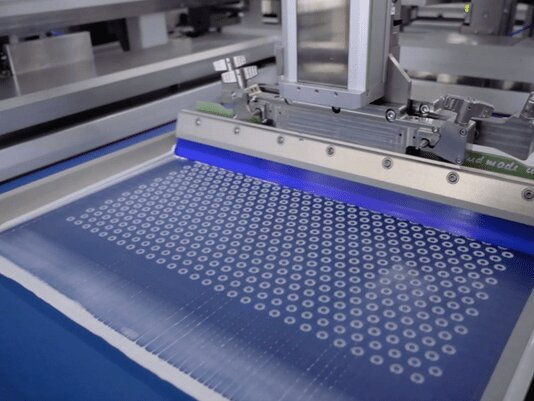Scalable 3D Screen Printing - High Degree of Freedom in Terms of Drug Choice
- Frances Hoggard
- Apr 21, 2021
- 4 min read
Updated: Mar 27, 2023
Additive manufacturing has the potential to revolutionize the pharmaceutical industry, enabling the production of customized drugs for the mass market. However, concerns over scalability, low mechanical resistance, low printing resolution, and limited material choices have hindered the practical application of current 3D printing (3DP) technologies. Although conceptually similar, each uses its method to deposit and cure the material. These limitations are highlighted by the fact that only a single 3D-printed medicine, Spritam® (an antiepileptic), is currently FDA-approved and marketed.
Scaling Production with 3D Screen Printing
We reported in Moldenhauer et al. the first proof of- concept study on 3D screen printing, termed SPID® (Screen Printing Innovational Drug Technology), in the fabrication of a drug delivery system (DDS). 3D screen printing uses a screen mesh to transfer a semi-solid, active pharmaceutical ingredient (API) containing paste onto a substrate, except in areas made impermeable by a blocking stencil. The deposited layer is then dried. The next layer is printed precisely on top of the previous one after lifting the screen by the dried layer thickness. This approach is based on the classic flatbed screen printing process widely used in industrial applications such as textile prints, electronic circuit boards, and precision materials. Critical advantages of screen printing versus other 3D printing technologies are the high freedom in the choice of materials and the number of tablets able to be produced at one time. 3D screen printing enables the build-up of thousands of units per screen. This is in stark contrast to other 3DP technologies that can only simultaneously produce one tablet per printing head. Using our current screen size, we can print between 12,000 and 40,000 tablets simultaneously, depending on the size of the tablets.
In Moldenhauer et al., SPID® was used to produce paracetamol (acetaminophen) tablets in five different geometries (disk, donut, cuboid, oval, and grid) in three different sizes (small, medium, large). We applied 100 printing cycles, each delivering layers of 20 μm in thickness. Produced tablets were highly uniform in their size, mass, breaking strength, fragility, the weight percentage of the API (paracetamol) per tablet, as well as their dissolution in artificial stomach acidic conditions (pH 1.2). Physical testing of the printed tablets demonstrated them to be on par with other established 3D printing techniques and, most importantly, with conventional tablet production, especially with regard to hardness. Furthermore, tablets were printed in accordance with relevant regulatory requirements outlined in the current European Pharmacopoeia supporting SPID®’s viability for manufacturing solid oral dosage forms.
3D printing, including screen printing, also has the potential to fabricate more complex DDS, including those with multiple APIs. We additionally showed the feasibility in our publication to print tablets with differently colored pastes to demonstrate this. Ongoing studies are currently addressing combinations of different APIs and excipients. Preliminary work indicates that the paste we developed for our proof-of-concept test is capable of accommodating other notable APIs, including, but not limited to, Dapsone (sulfone; antimicrobial and anti-inflammatory activity) and Levodopa (dopamine precursor) (Table 1). Interestingly, the developed paste can be used to print API-containing tablets in all four Biopharmaceutics Drug Disposition Classification System (BDDCS) classes.
API Name | Indication | BDDCS Class | Water Solubility [mg/mL] | LogP |
Paracetamol | Analgesic for mild to moderate pain and fever | 1 | 23.7 | -0.8 |
Levodopa | Dopaminergic agent for Parkinson's disease | 1 | 1.65 | -2.74 |
Pyrazinamide | Antimycobacterial for tuberculosis | 1 | 15 | -0.6 |
Dapsone | Antimycobacterial for leprosy and anti-acne agent | 2 | 0.2 | 0.97 |
Chloroquine | Antimalarial | 3 | 100 | 4.63 |
Trimethoprim | Antibacterial mainly for bladder infections | 3 | 1.37 | 0.91 |
Acyclovir | Antiviral for herpes simplex virus, chickenpox and shingles | 4 | 2.5 | -1.56 |
Table 1: Example APIs printed using 3D screen printing defined in Moldenhauer et al. Classification of APIs according to the Biopharmaceutics Drug Disposition Classification System (BDDCS) where Class 1 is characterized by High Solubility and Extensive Metabolism; Class 2 Low Solubility, Extensive Metabolism; Class 3 High Solubility, Poor Metabolism, and Class 4 Low Solubility, Poor Metabolism. LogP serves as a measure of the relationship between the lipophilicity and hydrophilicity of a substance. Values greater than one indicate higher solubility in organic solvents (e.g., n-octanol), and values below one indicate better solubility in water.
The solubility of a drug is a key parameter to achieve the desired concentration of a drug in circulation and, thus, the desired pharmacological response. Around 40% of new chemical entities developed are practically insoluble in water leading to slow drug absorption and inadequate and variable bioavailability. This is a major challenge for the formulation and development of new medications. The ability to print examples from all BDDCS classes suggests that a broad spectrum of APIs could be printed using SPID®. Future work will identify pastes with different release profiles, such as those amenable to immediate drug release.
Applications in Dentistry
Dentistry is uniquely positioned to catalyze the widespread use of 3DP pharmaceuticals as it already relies on a high level of customization. 3DP in the dental field was introduced more than a decade ago. Digital workflows incorporating 3DP technologies are now widely used to construct dental implants, prostheses, braces, and surgical guides.
Topical anesthetics are frequently used to anesthetize the gum before tooth extraction, root canal, and other dental surgeries. However, commercially available medications are available in foams, ointments, pastes, creams, and gels, which are often not able to provide a prolonged effect orally. Additionally, spreading within the oral cavity can lead to numbness in the mouth and throat that can lead to issues swallowing and, in some cases, choking, especially in young children.
Some interesting proof-of-concept work has already been performed using 3D printing to fabricate customizable dental anesthetic patches loaded with lidocaine to increase effectiveness and decrease transmission to off-target areas. Customized dosing for vulnerable populations seeking dental treatments, such as pediatric and elderly patients, could greatly benefit from such API-containing systems in the form of patches, tablets, implants, and films generated from 3D screen printing approaches such as SPID®. Another potential application would be solid dosage forms releasing anti-inflammatory and/or antimicrobial substances (alone or in combination) for root canal treatment.
Conclusion
The 3D screen printing technology SPID® enables the translation of the advantages of additive manufacturing processes (e.g., high flexibility regarding geometry and size; complex architecture) into a large-scale serial production suitable for mass market applications.
Conflict of Interest Disclosure
Acknowledgment

Laxxon Medical is dedicated to engineering patented 3D pharmaceutical solutions which optimize products and benefit patients. We aim to establish SPID®-Technology as a manufacturing process with the individual and the pharmaceutical partner in mind.


